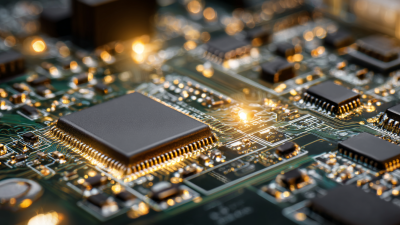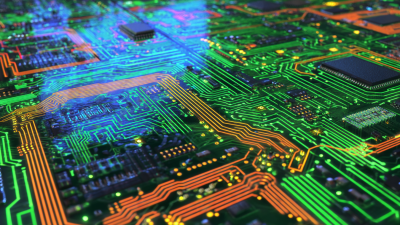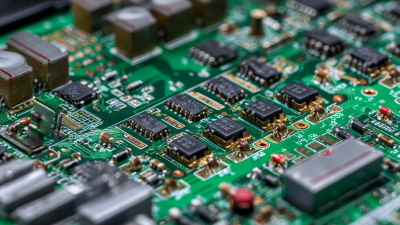Exploring Innovations in Printed Circuit Board Technology at the 138th Canton Fair 2025
As we approach the 138th Canton Fair in 2025, the spotlight is set to shine on groundbreaking advancements in printed circuit board technology. This event, renowned for its vast array of innovations, will serve as a pivotal platform for showcasing the latest developments in the PCB industry.
 Printed circuit boards play a critical role in the modern electronics landscape, providing the essential backbone for devices ranging from smartphones to sophisticated industrial machinery. At this year's fair, exhibitors will present cutting-edge solutions that enhance functionality, reduce costs, and improve sustainability in PCB manufacturing.
Attendees will have the opportunity to engage with leading manufacturers, explore new materials and techniques, and discuss the future trends driving the evolution of printed circuit board technology.
As industries continue to embrace digital transformation, the innovations unveiled at the Canton Fair will undoubtedly shape the direction of PCB applications in the years to come.
Printed circuit boards play a critical role in the modern electronics landscape, providing the essential backbone for devices ranging from smartphones to sophisticated industrial machinery. At this year's fair, exhibitors will present cutting-edge solutions that enhance functionality, reduce costs, and improve sustainability in PCB manufacturing.
Attendees will have the opportunity to engage with leading manufacturers, explore new materials and techniques, and discuss the future trends driving the evolution of printed circuit board technology.
As industries continue to embrace digital transformation, the innovations unveiled at the Canton Fair will undoubtedly shape the direction of PCB applications in the years to come.
Innovative Trends in PCB Design and Production Processes at Canton Fair 2025
At the 138th Canton Fair in 2025, the focus on printed circuit board (PCB) technology has never been more pronounced, with innovative trends shaping the design and production processes. Recent industry reports indicate that the global PCB market is projected to reach approximately $80 billion by 2026, driven by the surge in electronic device manufacturing and IoT applications. This growth has prompted manufacturers to adopt advanced materials and techniques, such as flexible PCBs and high-density interconnect (HDI) technology, which optimize space and enhance performance for modern devices.
Moreover, sustainability in PCB production is gaining traction, with many companies now implementing eco-friendly practices and materials. A report from IPC—Association Connecting Electronics Industries highlights that nearly 40% of PCB manufacturers are investing in green technologies to minimize waste and reduce their carbon footprint. At the Canton Fair, attendees can expect to see innovations in automated production processes that not only increase efficiency but also improve precision. These advancements signify a crucial shift towards more sustainable production methodologies while addressing the growing demands of an ever-evolving electronics landscape.

Impact of Advanced Materials on PCB Performance and Reliability at the Fair
At the 138th Canton Fair in 2025, the spotlight is firmly on the advancements in printed circuit board (PCB) technology, particularly focusing on the use of advanced materials that significantly enhance PCB performance and reliability. As electronics continue to evolve, the demand for high-performance printed circuits has never been greater. Manufacturers are increasingly turning to innovative materials such as high-frequency laminates, flexible substrates, and advanced dielectric materials that not only improve signal integrity but also withstand harsher environmental conditions.
Moreover, the integration of these advanced materials leads to PCBs that exhibit superior thermal management, reduced electromagnetic interference, and enhanced durability. For instance, the utilization of ceramic-filled epoxy resins can substantially increase the thermal conductivity of PCBs, making them suitable for high-power applications. Attendees at the fair will have the opportunity to witness firsthand how these material innovations are transforming PCB designs, fostering greater reliability and efficiency in a wide range of industrial applications. This exploration of cutting-edge materials not only promises to redefine the standards for PCB manufacturing but also sets the stage for future innovations in the electronics industry.
Exploring Innovations in Printed Circuit Board Technology at the 138th Canton Fair 2025 - Impact of Advanced Materials on PCB Performance and Reliability at the Fair
| Material Type | Thermal Conductivity (W/m·K) | Dielectric Strength (kV/mm) | Impact on Performance | Impact on Reliability |
|---|---|---|---|---|
| FR-4 | 0.3 | 20 | Good for standard applications | Moderate |
| Polyimide | 0.2 | 25 | Excellent for high-temperature applications | High |
| Ceramic | 1.5 | 30 | Superior performance; high frequency | Very High |
| PTFE (Teflon) | 0.25 | 20 | Excellent for microwave applications | High |
| Nano-Coated Materials | 0.5 | 22 | Enhanced performance due to surface modifications | Enhanced |
Integration of IoT and Smart Technologies in PCB Applications Showcased in 2025
At the 138th Canton Fair in 2025, the integration of IoT and smart technologies into printed circuit board (PCB) applications was prominently showcased, reflecting the industry's evolution and the increasing demand for interconnected devices. According to a recent Market Research Future report, the global PCB market is expected to reach USD 85 billion by 2027, growing at a compound annual growth rate (CAGR) of 5.4%. This growth is largely fueled by advancements in IoT solutions, which are becoming increasingly critical in sectors such as automotive, healthcare, and consumer electronics.

Exhibitors at the Canton Fair highlighted several innovations that enhance the functionality of PCBs in smart technology applications. For example, manufacturers are now incorporating flexible and stretchable PCB designs, optimizing layouts for interconnected devices while ensuring reliability and performance under diverse conditions. As stated in a report from the IPC (Association Connecting Electronics Industries), more than 70% of PCB producers are investing in smart technology integration, signifying a collective move towards IoT-ready solutions that support real-time data transmission and connectivity. This trend not only facilitates smarter product designs but also ultimately contributes to more efficient industries and improved consumer experiences.
Analysis of Market Growth and Demand for PCBs in Emerging Sectors at the Event
The upcoming 138th Canton Fair in 2025 presents a significant opportunity to analyze the remarkable growth and rising demand for printed circuit boards (PCBs) in emerging sectors. As the backbone of the electronics industry, PCBs facilitate the operation of various electronic devices, and their importance continues to rise with the proliferation of innovative technological applications.
This increasing reliance on PCBs is driven by new-age sectors such as electric vehicles, renewable energy, and smart devices, which demand high-performance and highly customized circuit solutions.
Recent reports indicate that the PCB market has experienced substantial growth, with businesses reporting notable increases in revenues. This trend is fueled by a surge in orders across multiple industries, leading to significant investments in PCB production capabilities.
By examining these developments at the Canton Fair, stakeholders can gain insights into market trends and identify potential opportunities for collaboration, investment, and technological advancement in the PCB sector, ensuring they remain competitive in this rapidly evolving landscape.
Sustainability Practices in PCB Manufacturing Highlighted at the 138th Canton Fair
At the 138th Canton Fair 2025, the spotlight was on sustainability practices in printed circuit board (PCB) manufacturing. As industries increasingly recognize the environmental impact of their production processes, many exhibitors showcased innovative methods to reduce waste and enhance efficiency. This year's fair emphasized a shift towards eco-friendly materials and practices, promoting a more circular economy within the electronics sector.
One notable trend highlighted at the fair was the adoption of biodegradable substrates and low-impact manufacturing techniques. Companies presented their efforts to minimize harmful emissions and utilize renewable energy sources, aligning with global initiatives aimed at reducing carbon footprints. Furthermore, collaborative efforts between PCB manufacturers and technology innovators were evident, demonstrating a collective commitment to sustainability. This event served as an important platform for stakeholders to share insights and best practices, paving the way for a more sustainable future in PCB technology.
Innovations in Printed Circuit Board Technology - Sustainability Practices
Related Posts
-

How to Choose the Best PCB Fabrication Partner for Global Supply Chain Success
-

Common Issues Faced in High Density PCB Circuit Design
-

Ultimate Checklist for Selecting the Best PCB Fabrication Services Worldwide
-

The Future of Smart PCB Board Technology in Electronics
-

Understanding Product Features and Applications in Best PCB Manufacturing and Assembly
-

Understanding the Challenges in Achieving Best PCB Assembly Quality
